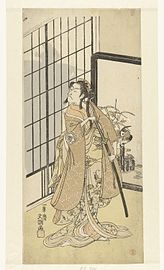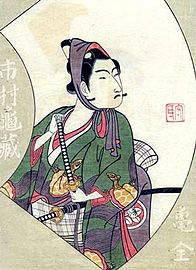Ippitsusai Bunchō (一筆斎文調, fl. 1755–1791) was a Japanese ukiyo-e artist,[1] best known for his yakusha-e actor prints in narrow hosoban dimensions.[2] Bunchō and Katsukawa Shunshō are credited with having developed kabuki actor portraiture focuses on producing likenesses of the subjects, rather than stereotyped faces.[3]
Little is known about Bunchō's life. His birth surname was Mori, and he is believed to have studied painting under Ishikawa Yukimoto of the Kanō school.[2][1]
The earliest known works attributed to Bunchō are the illustrations to Hachimonji Jishō II's Eiga asobi nidai otoko (1755). Between 1766 and 1774 he made a large number of actor prints in the narrow vertical hosoban dimensions. In 1770 he produced the three-volume Ehon butai ōgi (絵本舞台扇, "Picture-book of Stage Fans") with Katsukawa Shunshō, which depicts the leading kabuki actors of the day on ōgi hand fans; Bunchō handled the onnagata—male actors who portray female characters.[2] It was popular and went through multiple printings.[4]
From 1769 he also made bijin-ga prints of female beauties that show the influence of Suzuki Harunobu.[2] These became his major subject, and in the An'ei era (1772–81) no actor prints of his are known.[4]
Bunchō's last known work was an e-goyomi picture calendar from 1790. He had few students, one of whom was Kishi Bunshō (1754–96).[2]
- Works by Ippitsusai Bunchō
-
Matsumoto Koshiro III as Soga no Goro
-
Matsumoto Koshiro as Asagao
-
Actor and Courtesan Parodying the Armor-Pulling Scene from the Story of the Soga Brothers
-
An Actor of the Ichikawa School about to Draw His Sword
-
The Toothbrush Shop Yanagi-ya
-
Ichimura Uzaemon IX and Otani Hiroji III
-
Ichimura Uzaemon X
-
Courtesan with a Dog
References
edit- ^ a b "Ippitsusai Bunchō | Ukiyo-e, Kabuki, Printmaker | Britannica". www.britannica.com. Retrieved 2023-12-21.
- ^ a b c d e Marks 2012, p. 48.
- ^ Japan Ukiyo-e Association 1982, p. 120.
- ^ a b Fujisawa 2006, p. 48.
Works cited
edit- Fujisawa, Akane (2006). "Ippitsusai Bunchō". In Kobayashi, Tadashi (ed.). Ukiyo eshi retsuden 浮世絵師列伝. Bessatsu Taiyō (in Japanese). Heibonsha. pp. 48–49. ISBN 9784582944938.
- Japan Ukiyo-e Association (1982). Genshoku Ukiyo-e Dai-Hyakka Jiten 原色 浮世絵大百科事典 第6巻 [Original Colour Grand Ukiyo-e Encyclopaedia]. Vol. 6. Taishūkan Publishing.
- Marks, Andreas (2012). Japanese Woodblock Prints: Artists, Publishers and Masterworks: 1680–1900. Tuttle Publishing. ISBN 978-1-4629-0599-7.
External links
edit- Media related to Ippitsusai Bunchō at Wikimedia Commons
- Ippitsusai Bunchō at ukiyo-e.org








